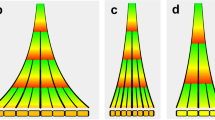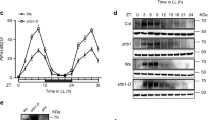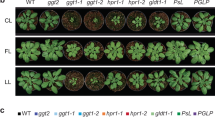Abstract
To identify the steps controlling a developmental response, we must relate changes occurring soon after the inducing signal to responses many hours later. In higher plants exposure to red light shifts developmental patterns by converting phytochrome, a ubiquitous plant pigment, into its active form1. Far red light converts phytochrome back to its original form and stops the response. Red light induces changes in electrical properties of plants in 15–30s (refs 2, 3) and within minutes ATP levels4, NADP transport5, and nitrate reductase activity6 change. It requires hours or even days for phytochrome effects on circadian rhyythms7, germination, de-aetiolation, and flowering responses to appear1. Until now there has been no indication of the mechanism by which events immediately following phytochrome conversion determine the later development. It should be possible to probe the nature of the first controlling steps by perturbing these steps and thus affecting growth. If the steps directly following phytochrome conversion are sensitive to additional red light, then a second illumination will alter the overall growth. We have found that a brief flash of red light given to dark-grown bean seedlings starts oscillations in a temperature-compensated system. The interaction of this system with a second flash of red light showed that the oscillating system controls subsequent development.
This is a preview of subscription content, access via your institution
Access options
Subscribe to this journal
Receive 51 print issues and online access
$199.00 per year
only $3.90 per issue
Buy this article
- Purchase on Springer Link
- Instant access to full article PDF
Prices may be subject to local taxes which are calculated during checkout
Similar content being viewed by others
References
Briggs, W. R., and Rice, H. V. Ann. Rev. Plant Physiol., 23, 293–334 (1972).
Newman, I. A., and Briggs, W. R., Pl. Physiol., 50, 687–693 (1972).
Racusen, R. H., and Etherton, B. Pl. Physiol., 55, 491–495 (1975).
Kirshner, R. L., White, J. M.,and Pike, C. S., Physiol. Plant., 34, 373–377 (1975).
Manabe, K., and Furuya, M. Pl. Physiol., 53, 343–347 (1974).
Johnson, C. B., Planta, 128, 127–132 (1976).
Simon, R., Satter, R. L., and Galston, A. W., Pl. Physiol., 58, 421–425 (1976).
Filner, B., and Klein, A. O. Pl. Physiol., 43, 1587–1596 (1968).
Mohr, H., Photochem. Photobiol., 20, 539–542 (1974).
Author information
Authors and Affiliations
Rights and permissions
About this article
Cite this article
GREGORY, A., KLEIN, A. Phytochrome-initiated fast rhythm controlling developmental response. Nature 265, 335–337 (1977). https://doi.org/10.1038/265335a0
Received:
Accepted:
Issue Date:
DOI: https://doi.org/10.1038/265335a0
Comments
By submitting a comment you agree to abide by our Terms and Community Guidelines. If you find something abusive or that does not comply with our terms or guidelines please flag it as inappropriate.



